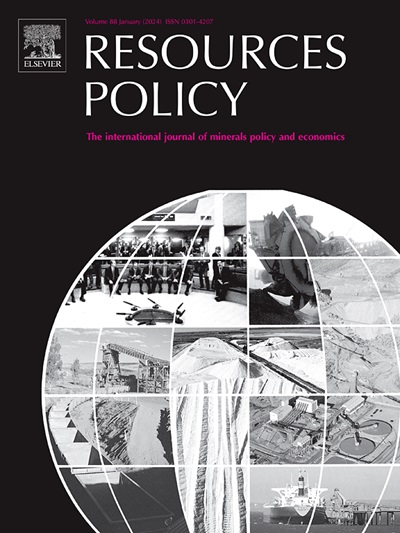Production and supply dynamics (2017–2023) associated with artisanal and small-scale mining of critical raw materials in Africa
IF 10.2
2区 经济学
0 ENVIRONMENTAL STUDIES
引用次数: 0
Abstract
Recent studies and policy developments have raised the question to what extent artisanal and small-scale mining (ASM) activities might contribute to the global supply of critical raw materials (CRM) for the energy transition and other strategic industrial sectors. This study presents the results of an Africa-wide screening of CRM production in the ASM sector, including an overview of selected mineral economic production parameters and production estimates for copper, cobalt, lithium, tantalum and tungsten. Based on these data, commodity price and ASM production development in the 2017–2023 period often show broadly aligned patterns characterized by strong volatility. In recent years, the African ASM contribution to global mine supply has been in the range of 1–12 % for copper, cobalt, lithium and tungsten, and 52–74 % in the case of tantalum. While ASM is thus already making a meaningful contribution to global supply, we present a number of potentially limiting geological, economic and legal factors that impact on the sector's long-term CRM production capacities and the ability by Western mid- and downstream market participants to directly access this supply. These factors include finite ASM-accessible CRM resources and the lack of information concerning the size of these resources, associated financing constraints, competing commodity price developments as well as corporate reputational considerations. Factoring in these parameters may be beneficial for calibrating forward-looking strategic CRM supply scenarios and for conceptualizing potential support or policy interventions in association with the ASM sector to stimulate investment and supply chain engagement.
与非洲手工和小规模关键原材料开采相关的生产和供应动态(2017-2023)
最近的研究和政策发展提出了一个问题,即手工和小规模采矿活动可能在多大程度上促进能源转型和其他战略工业部门的关键原材料的全球供应。本研究介绍了非洲范围内ASM部门CRM生产筛选的结果,包括对选定矿物经济生产参数的概述以及铜、钴、锂、钽和钨的产量估计。基于这些数据,2017-2023年期间的大宗商品价格和ASM产量发展通常显示出强烈波动的大致一致的模式。近年来,非洲对全球铜矿供应的贡献在铜、钴、锂和钨的1 - 12%之间,钽的52 - 74%之间。虽然ASM已经为全球供应做出了有意义的贡献,但我们提出了一些潜在的限制地质、经济和法律因素,这些因素会影响该行业的长期CRM生产能力,以及西方中下游市场参与者直接获取这些供应的能力。这些因素包括有限的asm可访问的CRM资源,缺乏有关这些资源规模的信息,相关的融资限制,竞争商品价格的发展以及公司声誉的考虑。考虑这些参数可能有利于校准前瞻性的战略性CRM供应方案,并概念化与ASM部门相关的潜在支持或政策干预,以刺激投资和供应链参与。
本文章由计算机程序翻译,如有差异,请以英文原文为准。
求助全文
约1分钟内获得全文
求助全文
来源期刊

Resources Policy
ENVIRONMENTAL STUDIES-
CiteScore
13.40
自引率
23.50%
发文量
602
审稿时长
69 days
期刊介绍:
Resources Policy is an international journal focused on the economics and policy aspects of mineral and fossil fuel extraction, production, and utilization. It targets individuals in academia, government, and industry. The journal seeks original research submissions analyzing public policy, economics, social science, geography, and finance in the fields of mining, non-fuel minerals, energy minerals, fossil fuels, and metals. Mineral economics topics covered include mineral market analysis, price analysis, project evaluation, mining and sustainable development, mineral resource rents, resource curse, mineral wealth and corruption, mineral taxation and regulation, strategic minerals and their supply, and the impact of mineral development on local communities and indigenous populations. The journal specifically excludes papers with agriculture, forestry, or fisheries as their primary focus.
 求助内容:
求助内容: 应助结果提醒方式:
应助结果提醒方式:


